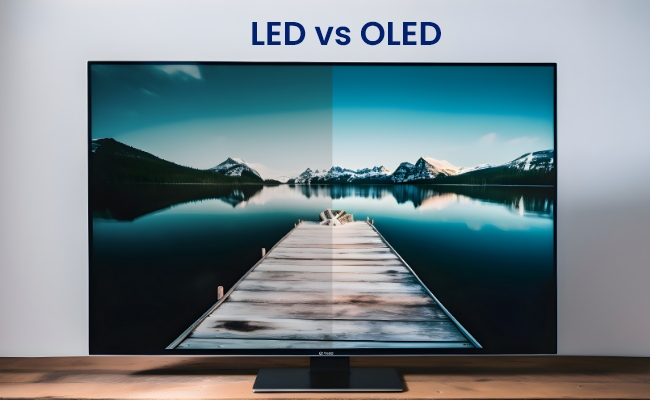LED vs OLED: What's the Difference?

If you are buying a TV or display, you might have come across these two words: LED and OLED. These are two distinct display technologies, but you have to choose one according to the application and your preferences.
In this article, we will discuss the difference between LED and OLED. We will understand the basics of these display technologies and share the pros and cons of both. We will also explain their suitable applications to help you make the right choice.
Note: Don’t miss Reolink’s Holiday deals for exclusive discounts on security cameras!
Reolink New Year Sale - Save Big with Exclusive Deals!
Save big with Reolink! New Year Sale up to 45% off on security cameras, doorbells, and systems — Dec. 8 to Jan. 4.
LED vs OLED: Basic of LED
What is LED?
An LED display is actually the advanced version of an LCD display. It also contains a liquid crystal solution to display images. However, it contains LEDs (Light Emitting Diode) at the back for backlighting.
The liquid is placed between two polarizing material sheets. When electricity is passed, the image is created on the screen. However, it requires backlighting to make the image more visible. Therefore, a series or array of LEDs is created to make everything well-lit.
Pros and Cons of LED
Pros:
- LED displays can last longer compared to OLEDs. They can offer optimal performance for a long time.
- The brightness of LED displays is exceptional because they have backlight technology.
- It’s an affordable option and offers excellent value for money
- No burn-in issues
Cons:
- A bit thick and bulky due to the backlight
- The viewing angles can be limited
- Lower contrast ratio
LED vs OLED: Basic of OLED
What is OLED?
OLED stands for Organic Light Emitting Diode. It also works on similar technology as LED, but it does not have a separate backlight system. Instead, each pixel in an OLED has its own light.
When the electricity is passed, each pixel generates light. These self-illuminating pixels emit light and offer better contrast and colors.
Pros and Cons of OLED
Pros:
- OLED displays are quite thin and slim as they do not need separate backlighting
- They offer vivid colors, a superior contrast ratio, and perfect black levels.
- The response time of OLEDs is faster than LEDs. They offer higher refresh rates.
Cons:
- OLEDs are more expensive
- They do not last as long as LEDs
- Burn-in is a common issue in OLEDs
LED vs OLED: What's the Difference?
Let’s compare LED vs OLED in different aspects.
Lighting Technology
There is a separate lighting technology in LEDs. It’s at the back of the liquid crystal display. These LEDs illuminate the screen and make the image more visible.
In OLEDs, there is no separate lighting technology. Each pixel is self-illuminating, which means it can produce light when electricity is passed.
Contrast Ratio
The contrast ratio of OLEDs is excellent. It offers an infinite contrast ratio, which is why the dark and bright points are visible clearly. They are quite vibrant and offer true colors.
On the other hand, LEDs offer a lower contrast ratio. It does not mean the quality of the image will be bad. It also offers accurate colors, but they won’t be as vibrant as in OLEDs.
Response Time
The response time of the OLED is quite high. Due to self-lighting pixels, the refresh rate is exceptional. You won’t notice motion blur and other issues while watching movies and gaming. They are suitable for fast motion graphics.
In contrast, the response time of LEDs is a little bit slow. They are also good for most applications, but when it comes to very fast-moving graphics, it is not the best choice.
Viewing Angles
You can view an OLED from any angle, and you will see vivid colors. You won’t notice any significant color distortion even if the viewing angle is changed a lot.
But in the case of LEDs, viewing angles matter. When you change the angle, the color, contrast, brightness, and other things will be affected. However, the recent LED technology does not have much difference when the angle is deviated.
Lifespan and Burn-in
LEDs last longer. They have a longer life up to 100,000 hours of use. Secondly, they are less susceptible to burn-in issues.
OLEDs have a shorter life, and their picture quality deteriorates over time. Moreover, they have burn-in issues, especially when a static image is shown for a longer time.
Power Efficiency
There is not much difference when it comes to power efficiency. But still, OLEDs are more efficient as they do not have a separate backlighting system.
LED vs OLED: Applications for them
Let’s see which type of display technology is suitable for different applications.
LED vs OLED TV
LEDs are commonly used in homes as they are affordable and long-lasting. They also offer good picture quality, so you can enjoy movies, shows, etc.
But if you care about an immersive experience just like a theater, you should go with an OLED TV. It is better in colors, contrast ratio, and viewing angles.
LED vs OLED for Gaming
For gaming, the ideal choice is an OLED display. It not only offers better image quality but also a high refresh rate. Gaming involves high-speed graphics, so good response time is essential for an immersive experience.
You can also enjoy games on LED displays. However, you might experience lag if the motion graphics are too high.
LED vs OLED for Monitor
For common office work, LED is a suitable option. It offers everything needed at a reasonable price tag.
But if high contrast and immersive graphics are needed, such as for video editing, OLED is better.
LED vs OLED for Laptop
LEDs are more common in laptops. They offer better battery life and image quality for normal usage.
For graphics designers and professionals, OLED laptops are more suitable. But they are expensive.
LCD vs LED vs OLED vs QLED: What's the Difference?
What is LCD?
LCD stands for Liquid Crystal Display. It’s the oldest of all these four display technologies. It uses special liquid crystals to produce images. It is extremely affordable and long-lasting. However, it has a limited viewing angle and slower response time.
What is QLED?
QLED stands for Quantum Dot Light Emitting Diode. It is the advanced version of LCD. It uses a quantum dot layer for backlighting. That’s why it offers incredible brightness, excellent colors, and a good contrast ratio.
It can be viewed from any angle and can even be placed in extremely bright areas. It also has a fast response time and high color accuracy. But all these things come with a higher price tag.
FAQs
1. Which is better LED or OLED?
Both technologies have distinct advantages and disadvantages. You have to choose one of them according to the application. For normal use, LEDs are good. For tasks that involve high-motion graphics, OLED is better.
2. Is LED or OLED better for eyes?
OLED is better for your eyes as it emits less blue light. It’s better in contrast and colors, so there is no strain on your eyes.
3. Is it worth buying OLED over LED?
Depending on the application, you can evaluate whether buying OLED or LED is worth it. For graphical tasks and immersive experiences, OLED is worth it. However, if you want to use it for normal tasks, such as coding, office work, and home entertainment, LED is worth it.
Conclusion
LED and OLED are both excellent display technologies that are still used. However, you have to choose one of them according to the application. We have explained the difference between them in detail and how you can select the right one according to your needs.
Search
Subscribe for the Latest Updates
Security insights & offers right into your inbox

